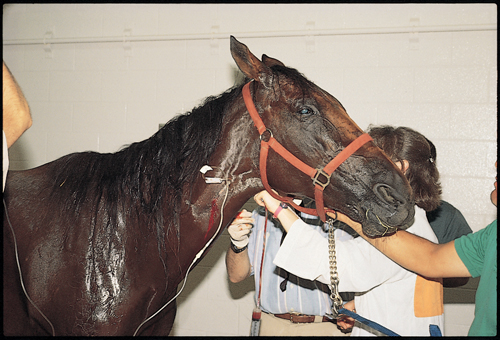Difference between revisions of "Equine Internal Medicine Q&A 08"
Ggaitskell (talk | contribs) (Created page with "{{Template:Manson Mair}} centre|500px<br> <br /> '''A 10-year-old Standardbred is presented for acute colic, fever (40°C) and fl...") |
|||
| (One intermediate revision by one other user not shown) | |||
| Line 13: | Line 13: | ||
|a1= | |a1= | ||
The unusual abdominal movement is synchronous diaphragmatic flutter (SDF). This occurs in association with abnormalities in phrenic nerve depolorization and it is activated with each atrial contraction. | The unusual abdominal movement is synchronous diaphragmatic flutter (SDF). This occurs in association with abnormalities in phrenic nerve depolorization and it is activated with each atrial contraction. | ||
| − | |l1= | + | |l1=Synchronous Diaphragmatic Flutter |
|q2=Which electrolytes would be predictably low in this case? | |q2=Which electrolytes would be predictably low in this case? | ||
|a2= | |a2= | ||
| Line 19: | Line 19: | ||
*The severe sweating and impending colitis would both result in hypochloraemia. <br><br> | *The severe sweating and impending colitis would both result in hypochloraemia. <br><br> | ||
The mare was treated with polyionic fluids and 23g of calcium borogluconate. The bloat and trismus resolved within one hour of the calcium therapy and the SDF disappeared within 12 hours. | The mare was treated with polyionic fluids and 23g of calcium borogluconate. The bloat and trismus resolved within one hour of the calcium therapy and the SDF disappeared within 12 hours. | ||
| − | |l2= | + | |l2=Synchronous Diaphragmatic Flutter#Diagnosis |
| − | |||
</FlashCard> | </FlashCard> | ||
Latest revision as of 15:05, 22 August 2011
| This question was provided by Manson Publishing as part of the OVAL Project. See more Equine Internal Medicine questions |
A 10-year-old Standardbred is presented for acute colic, fever (40°C) and fluidy gut sounds on abdominal auscultation. The mare is severely sweating, has tachycardia (90bpm) and tachypnoea, and there appears to be a quick abdominal movement which correlates in number with the heart rate. The mare also has abdominal distension, appears stiff and ataxic, and has trismus of the facial muscles.
| Question | Answer | Article | |
| What is the unusual abdominal movement? | The unusual abdominal movement is synchronous diaphragmatic flutter (SDF). This occurs in association with abnormalities in phrenic nerve depolorization and it is activated with each atrial contraction. |
Link to Article | |
| Which electrolytes would be predictably low in this case? |
The mare was treated with polyionic fluids and 23g of calcium borogluconate. The bloat and trismus resolved within one hour of the calcium therapy and the SDF disappeared within 12 hours. |
Link to Article | |
